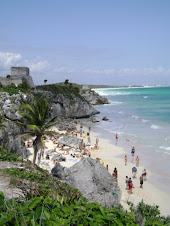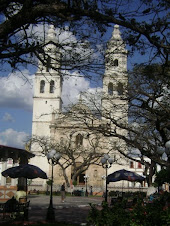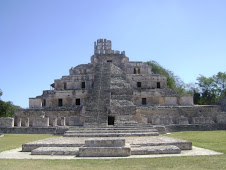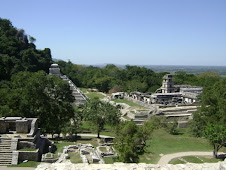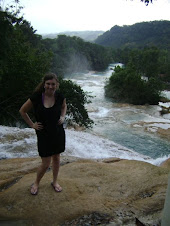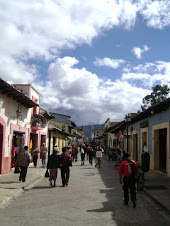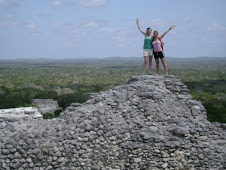If I had written a post about bull fights on Friday, it would have gone as follows:
I have never seen a bull fight, mostly because I think it is inhumane to kill an animal for spectacle and I do not enjoy the sight of blood.
However, four days later I have returned from my trip to Valladolid with a whole new opinion of corridas (bull fights). What follows is what I have learned first hand about the history, the tradition and the inner workings of a corrida.
It all started with our trip to Valladolid, a decent sized city about two hours east of Merida. Valladolid celebrates the Virgin of the Candelaria every year with a two week long feria. We decided to catch the second weekend of the feria to learn a little more about the town, the feria and the corridas.
I also had a friend from last year, Beto, who was in charge of the corridas for the feria so he talked us into coming to watch. Thanks to him, we got an in-depth look into what a corrida is.
On Saturday night, we headed to the feria with him and his friends to go to the concert of a woman named Yuri, who they told us was the Mexican equivalent of Madonna. We hopped into their truck to head to the feria but they warned us they had a little work to do first. For some reason, there was a mix up in hotel reservations and they had to find hotel rooms for 6 of the toreros (bull fighters). Finding a hotel in Valladolid at 8pm during feria is nearly impossible, so as we drove all around the city, from hotel to hotel, we got a little lesson about corridas.
First I learned that there are two main types of corridas: The first type is on foot, and is the type most of you have probably seen. The second type is done on horseback. This is where the matador, or in this case called a rejoneador, fights the bull while riding a horse.
Beto also told us that if it weren't for bull fighting, the whole breed of bulls would go extinct. They use a special type of bull for bull fights because this type of bull is especially aggressive. Without bullfighting, there would be no need for these aggressive bulls. I think this helped me warm up to the idea of bull fighting.
During this time we were invited to go down early on Sunday to see the preshow for the corrida so we could see more about what goes on before the fight. However, Beto explained that getting ready for a corrida is a very sacred tradition that very few people have seen. All of those who are about to participate in the fight go through a ritual of putting on their elaborate costumes. He said that it takes them a long time to get dressed because the costumes are all sewn into place, not buttoned or zipped. Tradition that still alive today: one more point for corridas in my book.
Anyways, they eventually found a hotel and we headed to the concert, where we got down into floor seating - for free - and watched Yuri, who ended up being very much like a Mexican Madonna.
Then came Sunday's corrida, my first ever. It was done on horseback. We were able to head to the feria early and see all of the horses as they prepared them for the fight. During the corrida two different rejoneadores alternate between killing four bulls in total. Between the two men, they had brought 17 horses to ride throughout the show. So this gives you a clue as to how exhausting it can be on the horses. It can also be dangerous. The picture I have included is of us with one of the men braiding a horse before the show. In the picture you can clearly see the horse's scar from where it had been previously gored by a bull's horns.
After we poked around backstage, we ran around the feria for awhile with Beto's cousin Fernando, who ended up being a very good feria guide.
Then it was time for the big show. We got to stand right down on ground level, with only a little wooden fence separating us from the raging bull. I was a little nervous, and I don't think it helped that everyone kept telling us what to do in the event that a bull might jump the fence. But I was excited to get such a close look.
Before the bull fight started, we learned that if a bull is especially brave and fights really well, that they don't kill it. A white flag signals that the bull can live and he gets to spend the rest of his days on a ranch with 200 cows. While it may be rare, talk about a good life! One more point for bull fighting. In addition, the bulls that they use for the corrida are an average of 5 years old, which is much older than the the life of a commercial beef cow. If you can't tell, I'm starting to warm up to the idea of bull fights.
So we watched the opening parade, the bull fight, the bulls death and I managed to stop shaking. It was a little gory, but it wasn't as bad as I thought it would be. The ring side seats were pretty cool too. We got to see everything up close and I mean really up close! At some points I could have reached out and touched the bull. (For the record, if your ever face to face with a bull, don't move. When you move, it makes them more likely to charge.)
I was surprised at how many people it took to fight the bull. Not only was there the guy on the horse, but there were at least 4 to 6 other guys whose job was to distract the bull. They don't have swords, but they have capotes which are the capes that they use to distract the bull.
Then there were the forcados, who were the craziest of them all. They also, ironically, are the only ones who don't receive money for the corrida. This group of 8 guys, dressed in nothing but their elaborate costumes, line up and taunt the bull into charging at them. The first one, who is the one wearing the hat, then grabs onto the front of the bull's horns and holds on. The rest proceed to pile on until they have the bull somewhat under control. Then one guy grabs onto the bulls tail and hangs on as the rest run away. This guy is dragged around in a circle until he can make it away safely.
Finally the rejoneador gets off the bull calms it down and then gives it it's last big blow and then then the toredos finish him off quickly. Once the bull was dead, they cut off one of the bulls ears and gave it to the rejoneador who then walked around waving his "trophy" and receiving applause before throwing the bloody ear into the audience.
After the first fight was over, the second rejoneador fights the next bull. The first fighter gets a break. His camp, and by camp I mean swords and knives, were set up right next to us so he came over to say hello. He not only fought bulls, but it turns out he speaks perfect english too.
He answered all the millions of questions that we had about bull fights. You could tell he was clearly very passionate about his profession and he knew a lot about it. He gave us the history of the corridas, which date back to the time of the crusades. The catholics used bull fights as a way to prepare their horses and warriors for battle. Because the wars were fought on their territory, bull fighting has remained so important to the Spanish, and in a way, we have bull fighting to thank for our religion.
He also taught us that the bull's ear was considered kind of like a grade of how well the fight went. He told us that there is judge, like a judge judge, that officiates the fight. That way the matadors all follow the rules and can be fined or arrested if they don't comply. He explained that everyone doesn't want to see the bull suffer anymore than they do, so there is an officiate. He also decides, by how well the fight and death goes, what the matador receives. If it is just ok, he gets to stand in the middle of the ring and receives his applause. The next step up is getting to walk around the receive the applause. Then if he does a good job, he receives and ear; a really good job gets two ears; and the best job gets two ears and a tail.
So we proceeded to watch the next three fights and talked more with our new rejoneador friend, Gaston Santos. Only later did we find out that he was the best bull fighter in Mexico. Not too shabby of an experience for my first ever bull fight, huh. I guess if you're going to learn about corridas you might as well learn about from the best.
Oh, and I forgot to mention that someone gave us the ear of the bull to keep as a souvenir. As I stood in line for the women's bathroom with a bloody bull's ear in my hand, the ladies told me it would taste really good if you cut it up and fry it. Currently, it is sitting in the window of our room, right in between the piñata and my mexican cowboy hat. (Yes, we brought the bull's ear all the way back to Merida. What else are we going to do with it? If you have any suggestions, I'm open to ideas!)
After the corrida we watched as they cut up the toros to sell for food. I honestly watched as the skinned and cut up a whole toro. I think that it helped me to know that he didn't go to waste.
Ok, well I feel like I have written enough for one post, hope you all enjoyed my novel. I'm off to go celebrate my 21st!
My Lesson of the Day: Never say never, because one day you may have a bloody bull's ear in your hand too!
P.S. My pictures wouldn't load, so those will come later!

































